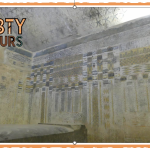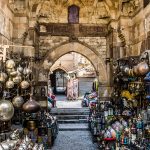The striking visual images of the deities of ancient Egypt are very well
known; the myths about them much less so. Egyptian religious art and
literature is full of allusions to myth but long mythical narratives are
comparatively rare. Egyptian religion had no official body of scriptures
and there seems to have been no standard collection of important
national myths. Our knowledge of Egyptian mythology has to be pieced
together from a variety of sources.
The surviving temples seem the obvious source, but they are not
necessarily the best one. The temples built in the south (Upper Egypt)
are better preserved than those of the north (Lower Egypt), so less is
known about deities whose main cult centres were in the north. For
much of the third millennium BC, the biggest and most elaborate temples
were those dedicated to dead kings. In the second millennium BC, many
large and magnificent temples were built for the gods and goddesses of
the Egyptian pantheon. Officially, the king was high priest of all these
state-run temples. The scenes and texts on the walls largely concentrate
on the relationship between the deity and the king. The daily liturgy was
designed to persuade deities to manifest themselves in the statues kept in
the holy of holies and to bestow blessings on king, people and country.
The temples celebrate the eternal power and serene benevolence of the
gods.
In myth, the gods are more vulnerable. They are subject to passions
and emotions, they quarrel, fight, and even die. This vulnerability was
largely taboo in Egyptian art. The power of words and images was
greatly increased when they were carved in stone to last for eternity.
A terrible event, such as the murder of the good god Osiris, was too
dangerous to show. Portraying even a temporary triumph for the forces
of evil or chaos might empower them to act in the world.
The rules governing what was depicted and written on temple walls
MYTH A N D MAGIC
changed somewhat during the first millennium BC. The temple of Hibis,
begun while the Persians were occupying Egypt in the late sixth century
BC, depicts an extraordinary range of mythical beings in its reliefs. The
great temples constructed under Greek and Roman rule, such as Dendera, Esna and Edfu,
are inscribed with elaborate texts dealing with both
creation and conflict.
A sequence of reliefs and inscriptions at Edfu tells of the struggle
between the forces of order, represented by the god Horus, and the
forces of chaos, represented by the god Seth. The evil manifestations of
Seth are shown on a tiny scale compared with the commanding figures
of the god Horus and his mother Isis . From the artistic point of
view, the effect is ridiculous, but good had to be shown as triumphant.
Evil had to be shown as bound to fail. Reducing the power of the enemy
by reducing his scale was a magical technique as well as an artistic
convention.
Statues and stelae set up in temples by private individuals are another




Very good https://is.gd/tpjNyL
Very good https://shorturl.at/2breu
Very good https://shorturl.at/2breu